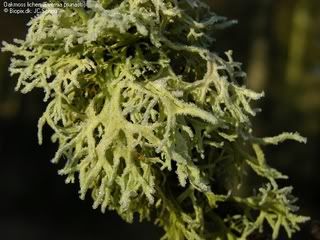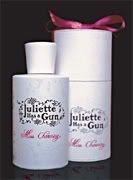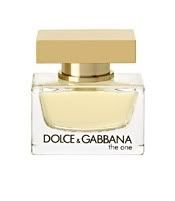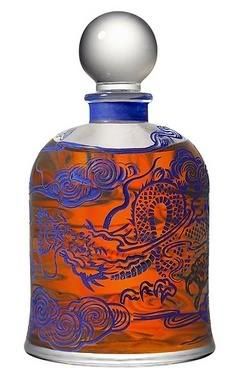
Oakmoss has got to be the most controversial ingredient in perfume in recent history. For years used for its mossy, sensual quality and an integral constituent of chypre compositions married to a citrusy top note, traditionally bergamot, it has gone under the strict scrutiny of European regulations and IFRA -the regulatory body for scent materials. And it became the controversial issue in relation to the alleged reformulation of classic Guerlain perfumes, resulting in brouhaha of gigantic proportions. Let's try to sort the mess out a bit.
Basically oakmoss is a type of light green to green black lichen, a fungus growing on trees found in many mountainous temperate forests throughout the Northern Hemisphere, including parts of France, Portugal, Spain, North America, and places in Central Europe (Yukoslavian oakmoss was very popular). It forms clumps of
bushy thalli. The growth of such lichens indicates good air-conditioning in those areas, as the organisms abhor pollution.
Oakmoss grows primarily on the trunk and branches of oak trees, hence the name (
mousse de chêne in French); but lichen is also commonly found on the bark of other deciduous trees and conifers (fir and pine). Technically oakmoss belongs to the genus
Evernia and is named
Evernia prunastri, differentiating it from its cousin tree moss growing on pines and firs,
Evernia Furfuracea. Interestingly, this last ingredient has been found packed into Egyptian mummies.
In perfumery oakmoss has been prized for its aroma, heavy and oriental-like at first, becoming very refined when dried, reminiscent of bark, seashore and foliage. It imparts a wet forest floor aroma in compositions resulting in a naturalness and rich earthy, damp and creamy undercurrent when used with restraint. Its remarkable quality is its ability to render a velvety softness to floral bouquets, green fragrances and heavy orientals alike, also possessing fixative properties imparting longevity in the perfumes that contain it and anchoring the more volatile notes.
Francois Coty, contrary to popular myth, was not the first one to capitalize on its fragrant properties in his
Chypre in 1917, which inaugurated a new fragrance family. He did make it popular though and is indirectly responsible for the birth of many wonderful spawns, so a belated huge thanks is in order.
Chypre means of course
Cyprus, the greek island of Venus with the rich history, and this is where the composition originated, albeit in a less standardised form, even from the time of Romans who created a mix of storax , labdanum and calamus (ingredients also present in chypre perfumes) in the island of Cyprus; this gave rise to the Middle Ages and Rennaisance alloys with oakmoss at its base.
We learn from Ayala’s excellent
Smelly blog that as early as the 12th century AD pastilles and “Oyselets de Chypre” (Chypre Birds) were made by mixing labdanum (a resinous material combed off the hair of goats grazing on cistus labdanum/rockrose), styrax and calamus, with the addition of tragacanth. This was burned as incense, alluding to the ancient ritual origins of perfume “perfumum” (=through smoke); while the birds served decorative purposes and scented the air. It wasn’t until the 14th century that oakmoss was added to these pastilles. Two recipes from 1777 for chypre compositions include oamoss as well as civet, ambergris, musk and various resins and plant aromatics, two of which are rose and orange blossom.
With Coty’s
Chypre though a new direction emerged resulting in a plethora of variations with such prestigious members such as
Femme, Mitsouko, Bandit, Jolie Madame, Tabac Blond, Cabochard, Cuir de Russie, Aromatics Elixir, Miss Dior, Diorella, Knowing, Ma Griffe, Paloma Picasso and hundreds of others.
The inclusion of oakmoss in those compositions was a foregone conclusion.
However the European Union allergens regulations have changed our understanding of that last part. Deeming oakmoss - and not only that one- an ingredient that has been tied to specific dermatological averse reactions they issued a list of restricted ingredients. The
Colipa site and especially the 7th and 36th amendment are of great interest to anyone researching this issue.
More specifically the IFRA regulation states that
"Oak moss extracts (e.g. absolute, resinoid, concrete, etc.) obtained
from Evernia prunastri should not be used such that the level in consumer
products exceeds 0.1%. In the presence of tree moss extracts the level of oak
moss has to be reduced accordingly such that the total amount of both extracts
does not exceed 0.1% in the final product.
Furthermore, oak moss extracts
used in perfume compounds must not contain added tree moss. Tree moss contains
resin acids. The presence of resin acids can be detected by using a routine
analytical method available from IFRA*. However, traces of resin acids are
unavoidable in current commercial qualities of oak moss. As an interim standard,
these traces must not exceed 0.1% (1000 ppm) dehydroabietic acid (DHA).
This
recommendation is based on test data on the sensitising potential of oak moss
and tree moss extracts, their cross-reactivity and the absence of sensitisation
reactions when tested at 0.6%. In addition, it has been shown that oxidation
products of resin acids contribute to the sensitising potential. This adaptation
to the Standard aims at reducing exposure to resin acids, while waiting for the
final outcome of a current research program.”
This ascertains that it is not oakmoss that is the culprit here, but probably its combination with tree moss. The issue however puts a spin on the reformulation of certain perfumes. Since the rise of the controversy it has been suggested that a warning label on the box of the perfume stating those specific ingredients included (more on that will be the theme of another article) might be the saving grace for those well-respected, nay treasured formulae of yore, especially the historic Guerlain ones
. Mitsouko and
Parure were prime candidates for a sweeping metamorphosis that would leave them harmed beyond any recognition. Lots of others as well. The official line of Guerlain PR had been denial of any reformulation up to a certain point in time, while in the last couple of years they admitted that the whole commercial line would be re-vamped by the end of 2005 to conform to IFRA regulations. No matter what solution might be suggested the result is that some amount of reformulation has indeed taken place (for the record, some people were in favour of the inclusion of the potential allergens with a warning on the box; others were championing the idea of including them only in parfum concentration or in the boutique exclusives, an idea that frankly reeks of elitism to me).
How could one preserve the use of oakmoss and where would one find it still then?
The “quenching” hypothesis is a fascinating proposition (Opduke as far back as 1976) and consists of the suggestion that inclusion of the anti-inflammatory azulene (naturally occurring in soothing chamomile) might cut down the risk of irritation presented by various objectionable ingredients.
However the odour profile of azulene coupled with its blue colour have presented the perfumer with a challenge as how to incorporate it in such a way as to remain in the wings.
The inclusion of eugenol and limonene at defined ratios to some other sensitising agents (cinnamaldehyde, citral, phenylacetaldehyde) is also worth exploring in regard to oakmoss.
It is debatable if the risk of a rash is so great a concern to warrant complete ban on specific ingredients for everyone. After all fyrocoumarin in elevated doses is also as much a suspect and even methyl eugenol which occurs in basil and rose oil has been called a systematic carcinogen. I do not see a ban on those however.
Many products
still use Evernia prunastri (oakmoss) in their formula , they even state so on the box, often with tree moss also included in defined ratios, while others capitalize on the alluring notion of bringing out our inner dryad while using this sensuous forest ingredient still.
Master perfumer
Arcadi Boix Camps claims to have succeeded in substituting oakmoss for other combinations that produce a comparative smell, however there is not enough searchable info on what exactly that might be.
Natural perfumers are continuing to use oakmoss absolute rendered by solvent extraction and state its constituents as evernic acid, d-usnic acid, atranorine and chloratronorine. According to Robert Tisserand it is indeed a dermal and mucous sensitiser that should be avoided in pregnancy and epilepsy, but its risks for general use are in direct proportion to the manner of use and ratio in a mix.
Like with everything else, an informed choice is the way to go and hopefully some aspects of oakmoss have been highlighted here.
A newer crop of perfumes that assume the identity of chypre under the alias “mossy woods” in Michael Edwards' classification of perfumes has cropped up in recent years resulting in offerings such as
Narciso for Her,
Lovely by Jessica Parker, Lauren’s
Pure Turquoise and Comme des Garcons
White. Those pleasant perfumes substitute oakmoss with a grassy background of patchouli and vetiver that somehow does not smell distinctly chyprish like the classic ones. Whether this is the only way to go for the chypres of tomorrow or there is still a place for traditional oakmoss-laden chypres remains to be seen.
Pic of oakmoss growth from biopix.com

.jpg)








